It’s a beautiful morning, you go out to the garden, and see holes all over your precious tomato plants.
There are plenty of pests that like to eat tomato plants just as much as we humans do.
Let’s walk through these four tomato eaters, and get some ideas on how to prevent and get rid of them when you do find them roaming around your garden.
What Kind of Worms Eat Tomato Plants?
But what kind of worms eat tomato plants? Tomato hornworms are the most common tomato eater, along with cutworms, armyworms, and loopers. These worms don’t just eat the leaves, they can also go after the flowers or buds, stems, and even the tomato fruit itself.
You can tell these worms apart by their appearance and the ways in which they attack the tomato plant.
While we think of them as worms, these are actually young caterpillars and are in the larval stage of the moths they turn into. Some of them blend in quite well, making it difficult to find them on your plants.
The main offender is the tomato hornworm.
1. Tomato Hornworms
If you notice big, green, juicy-looking worms on your tomato plants 🤢 you probably have a tomato hornworm problem. These suckers can get up to 5 inches long, that’s like the length of a dollar bill!
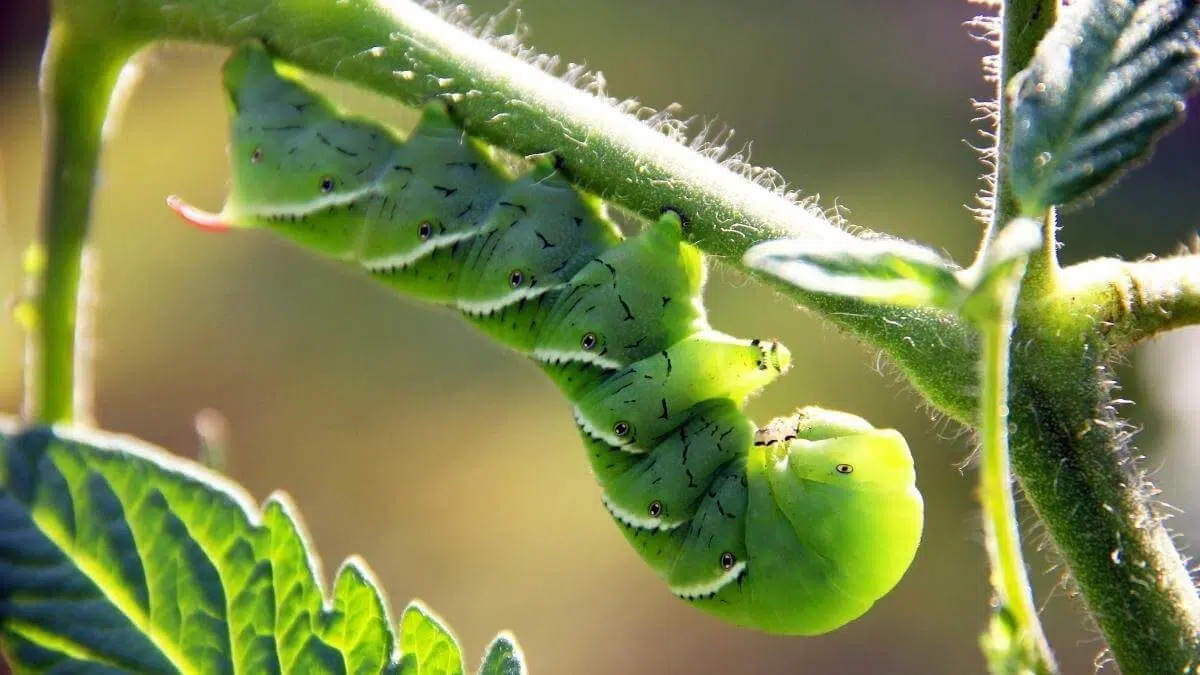
Hornworms are not actually “worms”, they are caterpillars that eventually turn into moths. And, if you live in the southern US, they might actually be tobacco hornworms.
How to Get Rid of Tomato Hornworms
There are a few different ways you can get rid of tomato worms. The options below are the most “natural” ways I know of.
While there are more options that involve chemicals and chemical-based sprays, I don’t want that soaking into my tomato plants and me eventually eating that.
Find Them at Night With a Blacklight Flashlight
This is so gross, but it is quite effective. You can pick up a blacklight flashlight on Amazon for around $10.
Wait until it gets dark enough out for them to appear. Tomato hornworms will glow when you shine a blacklight on them, so this is a super-effective way to find them.
Pro Tip: Don’t Touch the Worms Covered in White Rice
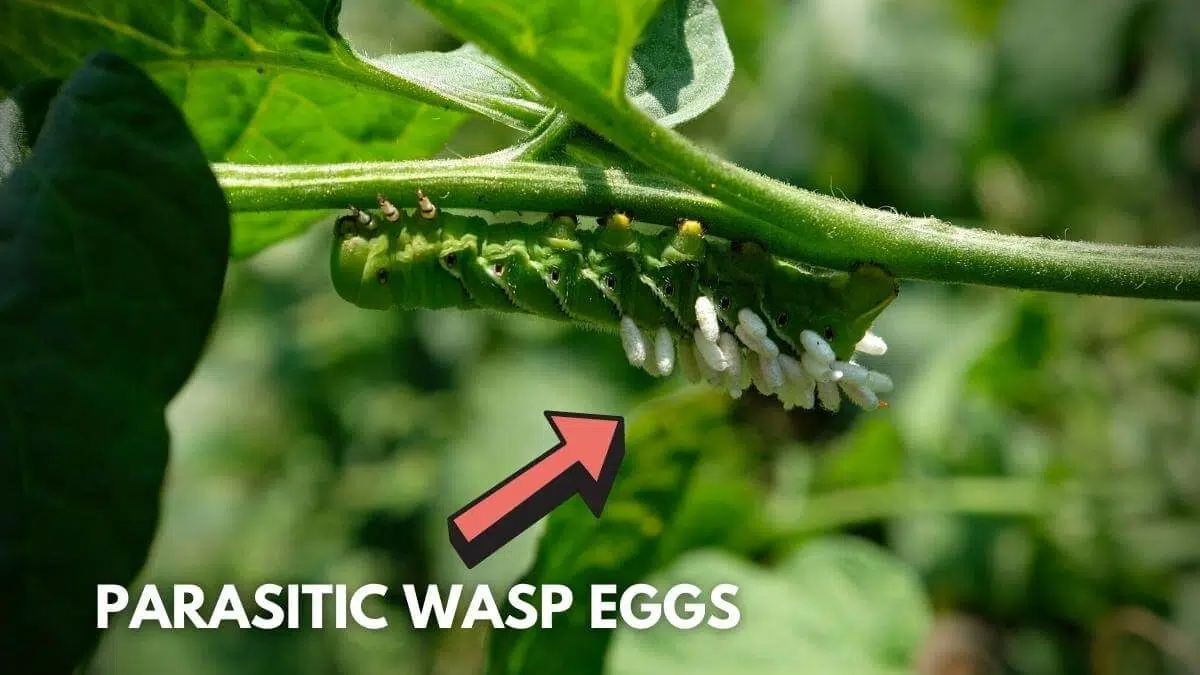
If you see a hornworm with white rice-looking things on it’s back, leave it alone. Those are parasitic wasp cocoons – and once those eggs hatch (gross I know) and immediately start feeding on that hornworm and any others in the surrounding area. That guy is a dead man walking!
If you find hornworms without those rice grains on them, you can put them in a mason jar or some other container as you walk around the garden gathering them. Wearing gloves makes this a little less….gross.
Once you’ve got them all, you can feed them to your chickens or the birds in your area. If you just want them gone, you can fill the jar with soapy water and that will take care of them for you.
Bacillus Thuringiensis (B.T.) Spray
B.T is a chemical that is used in organic gardening to help get rid of certain types of soft-bodied pests. It is a naturally occurring chemical.
When you spray it on the plant, the caterpillar needs to eat it for it to be effective, but since they eat seemingly everything on a tomato or pepper plant, this shouldn’t be an issue.
It only impacts certain types of moths and their caterpillars, like hornworms, gypsy moths, bagworms, and fall cankerworms. This works on cabbage loopers as well.
There are a few types of B.T. that target different pests, so make sure you’re getting the one that is Bacillus thuringiensis var. kurstaki.
Yes, that’s quite a few scientific words, but this is the one to get to make sure it’s the right variant.
B.t. is safe for pets, humans, and birds and bees as well. It really only impacts those worms and caterpillars.
You will want to spray the leaves fully with this stuff, the underside of the leaves, the stems, and all. If it rains, you’ll need to reapply it as it will have been washed off.
B.T. is a great spray for getting rid of hornworms and other unwanted caterpillars and worms that can destroy your garden plants and vegetables.
Worms are going to be something any gardener will have to deal with. Knowing what you’re up against, as well as what to look for and how to prevent/get rid of tomato worms is going to make all the difference.
When do Hornworms Show Up
Hornworms are the pupal stage of the adult hummingbird moth (also known as the sphinx moth), which is what they eventually turn into (unless you find them before they eat your tomato plant).
The moth will lay eggs on the tomato leaves of the host plant in the mid to late spring, and then about a week later, those eggs turn into the dreaded tomato hornworm.
Depending on your hardiness zone, you can expect tomato hornworms to appear around May or June.
How to Prevent Tomato Hornworms From Visiting Your Garden
There are a few options for helping to prevent hornworms from appearing in the first place. But knowing where they come from is important.
Tomato hornworms come from eggs laid by adult moths,
Companion Planting
The first is about companion planting, which is essentially growing plants nearby that help deters the pests that feed on that plant.
Some good companion plants that help keep hornworms away are:
- Basil
- Marigolds
- Dill
The second prevention method involves tilling. Some people are against tilling, so if that’s you, you can skip this part.
Hornworms spend winter in the ground and come out once spring arrives. Tilling is said to get rid of 90% of hornworm larvae in the soil.
But planting companions nearby can be a big help in keeping them away. Marigolds and tomatoes are some of the best companions because those beautiful flowers help repel hornworms and the moths they turn into.
What Do Hornworms Turn Into?
They turn into sphinx (aka hummingbird) moths, which are beneficial insects for native plants. That doesn’t make them any less destructive to your tomato plants.
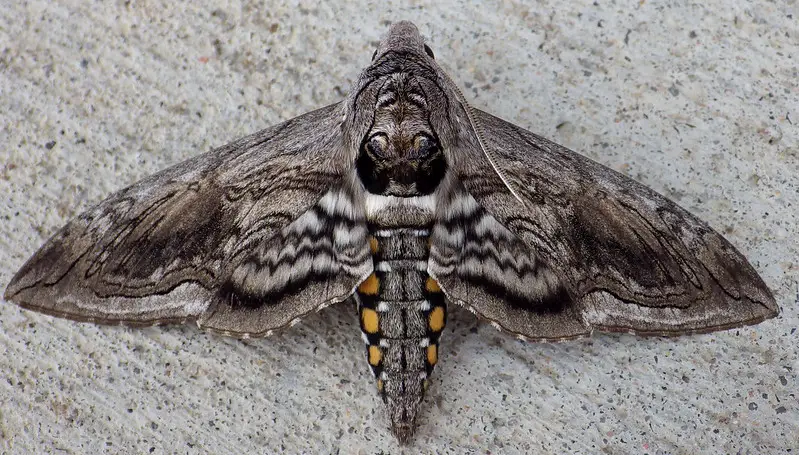
Can Plants Recover From Hornworms?
Yes, plants can recover from a tomato hornworm infestation. However, it can take a while to bounce back and if the hornworms did enough damage, the plant might not come back.
Determinate tomatoes will have a harder time recovering than an indeterminate plant. This is because the determinate produces only one set of fruit, so if the plant is stressed out and it ruins the fruit, you won’t get another batch of tomatoes from that plant.
2. Armyworms
Beet armyworms are notorious for grazing on tomato plants, potatoes, and cabbage.
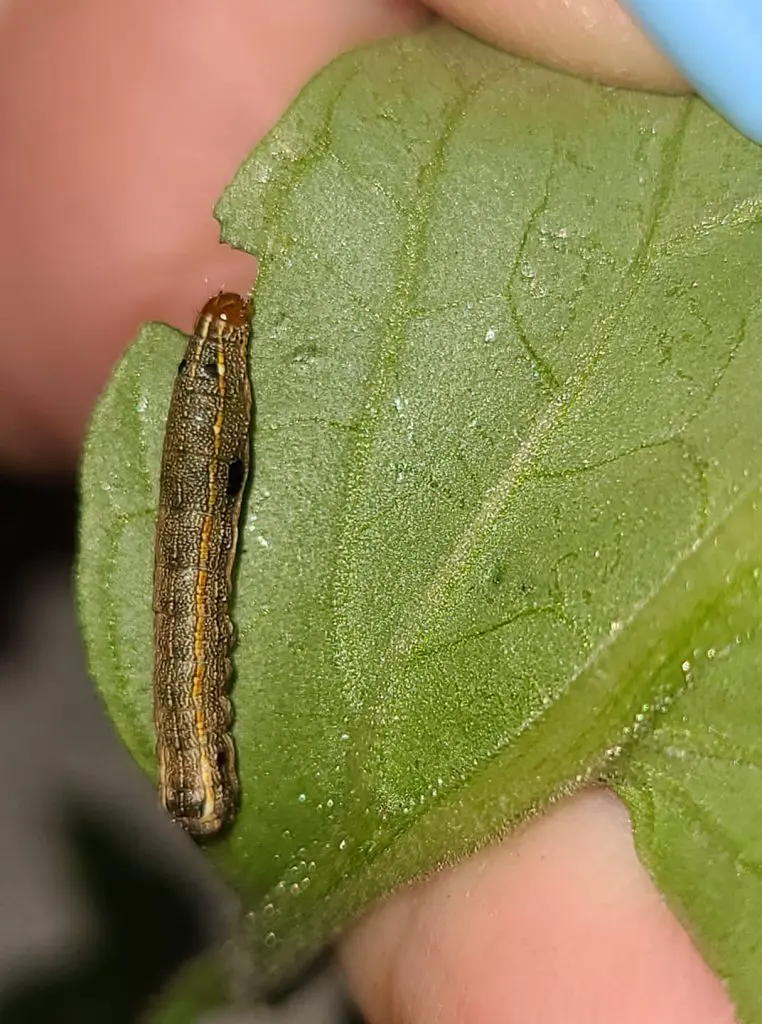
Armyworms generally wreak havoc in the late summer but can appear earlier in the season.
3. Loopers
Cabbage loopers are voracious eaters. I found this guy after finding holes in my plants, and looking at the underside of the leaf (where they hide).
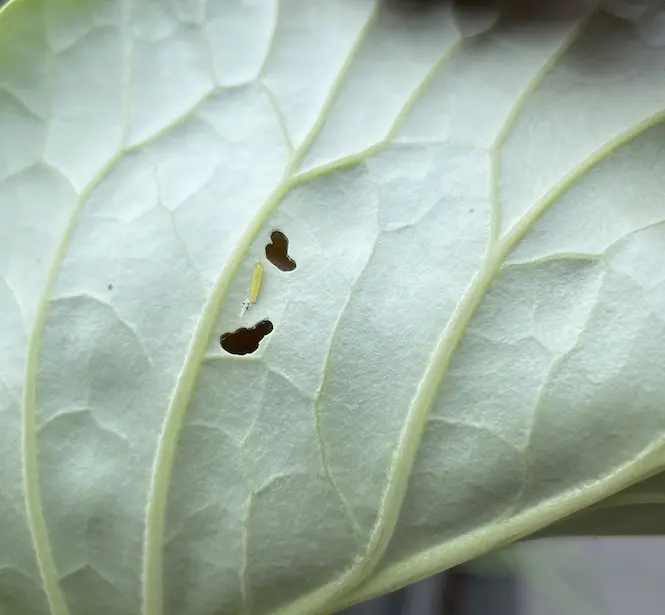
As their name suggests, loopers prefer cabbage and broccoli, but they will absolutely wreck a tomato plant as well if they’re available.
If you see holes in your cabbage or tomato plants, make sure to check the underside of the leaves, as that’s where eggs are laid and the larvae reside (gross).
Loopers turn into owlet moths, as shown below.
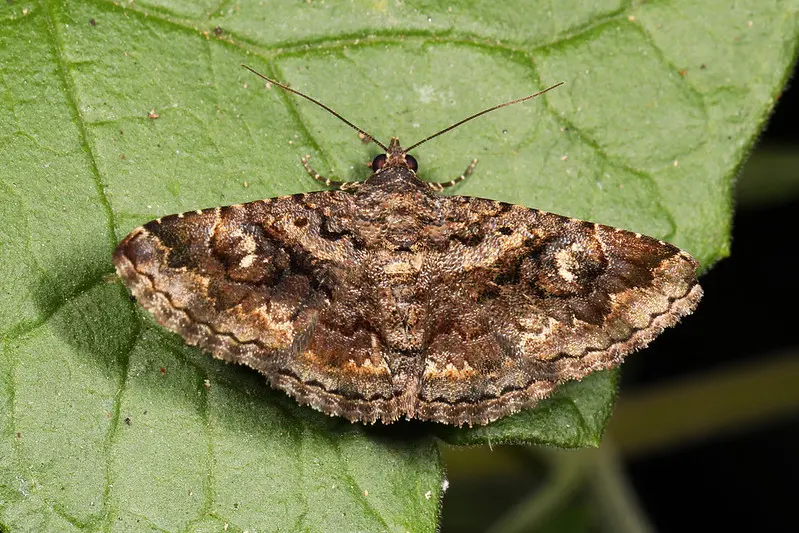
4. Cutworms
Another pest to keep an eye out for is cutworms. Cutworms are the larva of the turnip moth.
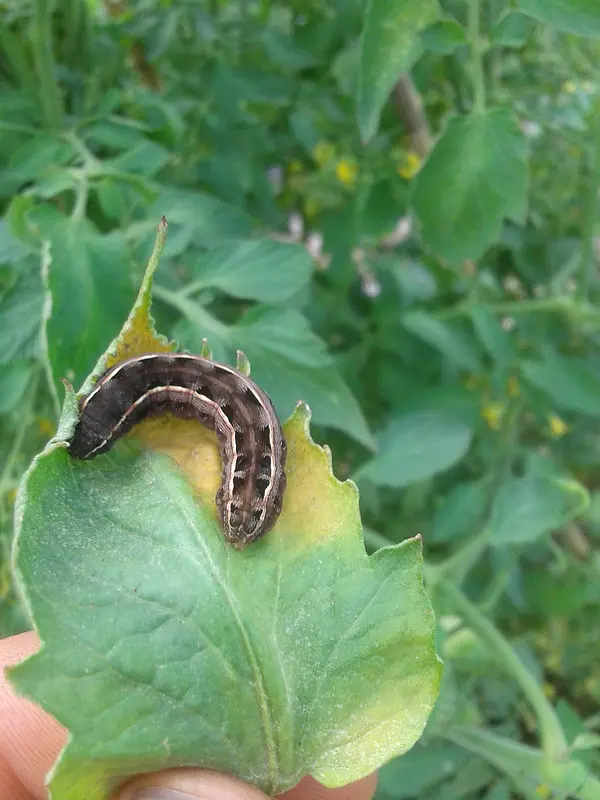
These guys will crawl around in the soil and attack the first plant they find, which if you’re like me and grow entirely too many tomato plants, could end up being on your tomatoes.
These generally go after the stems of seedlings and end up “cutting” it down, hence the name cutworm. But they can also attack leaves and flower buds, and will even destroy the whole plant.
Frequently Asked Questions
Do Tomato Hornworms Harm People?
Tomato hornworms don’t harm people. Aside from mentally after you see your tomato plants decimated overnight.
Should I Get Rid of Tomato Hornworms?
If you want to harvest any more tomatoes this season, you want to get rid of tomato hornworms as quickly as you can. They can quite literally eat tons of tomato leaves in a single night, causing the plant extreme stress and making it harder to recover.
Where Do Tomato Hornworms Go During The Day?
During the day, tomato hornworms can usually be found on the stems of the plant or underneath the leaves. They’ll usually wait until the temperatures cool down in the evening to start the real feast, but that doesn’t mean they can’t do damage during the day.
Do Tomato Hornworms Overwinter?
Yes, tomato hornworms can survive winter as pupae underground. In the spring, they will come out of the ground, quickly turning into an adult sphinx moth.



